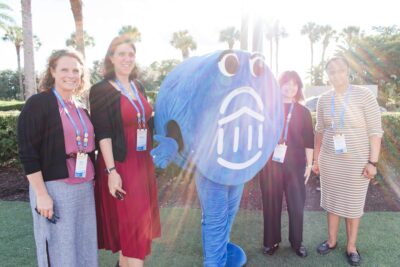4 ways AI can freeze summer melt at community colleges
I spent years working in two-year college admissions, and I’ll never forget the brief calm at the end of spring—right before the summer scramble began. Who still needed placement testing? Who had incomplete FAFSAs? Why were so many students this close to registering, only to walk away? How could we get them to attend orientation? It was exhausting and overwhelming—I cried at my desk more than once.
For community colleges, summer is a critical window to keep new students engaged and ensure they complete their enrollment steps before fall. Many students, especially first-generation or those juggling work and family commitments, struggle to navigate deadlines, financial aid requirements, and course registration. These challenges contribute to summer melt, which sees 10–40% of college-intending students not enrolling each fall. Melt rates are highest among low- and moderate-income students, those with lower academic achievement, and those enrolling at community colleges.
Perceptions of cost and ROI are also major factors in melt. As living expenses rise, more students face serious financial constraints. About 60% of students now question the value of a college education, adding to their hesitation. These financial worries often cause students and families to second-guess enrollment, weighing immediate costs against long-term benefits.
Meanwhile, community college staff—already stretched thin—often have limited summer availability, making it difficult to provide one-on-one support when students need it most. But new technology is available to help. Advances in artificial intelligence (AI) are bridging the gap by offering round-the-clock guidance, streamlining communication, and removing barriers to enrollment. By scaling the most time-consuming tasks, colleges can free up frontline staff to focus on students who need extra support—helping more students make it from summer to the first day of class.
Here are four ways EAB’s AI-powered tools help reduce summer melt so students can start the fall semester with confidence.
4 Ways AI Can Reduce Summer Melt
1. 24/7 Access to Enrollment Information with AI Agents
One of the biggest obstacles to completing enrollment—especially for new students—is simply not knowing what to do next. Many have questions about financial aid, placement testing, or advising but don’t know where to find the answers. They also may not have time for back-and-forth communication with the college or unnecessary trips to campus. This challenge is even greater for working students, as many inquiries arise outside traditional business hours, leaving them waiting for help or giving up entirely.
-
81%
of student success staff indicated that a confusing enrollment process is enough to cause a new student to not enroll.
AI chatbots, like EAB’s Student and Prospect Knowledge Agent, provide round-the-clock, institution-specific support by answering common student questions in real time. Instead of searching multiple webpages or waiting for an email response, students can receive instant guidance-in multiple languages- on questions such as:
- How do I submit my financial aid paperwork?
- How do I sign up for placement testing?
- Where do I find my course schedule?
- Where can I pay my bill?
- How do I sign up for orientation?
Since about 75% of student queries come outside normal office hours1 and some schools might have reduced hours in the summer, AI chatbots ensure that students don’t hit unnecessary roadblocks during the enrollment process. These tools can also escalate complex cases to human staff when needed, ensuring that students who require additional support receive timely follow-ups.
2. Instantly Create Tailored Outreach
Even when students have access to information, they often need reminders and encouragement to stay on track. Community colleges serve a diverse student population, many of whom juggle work, caregiving responsibilities, or other commitments that can make it difficult to prioritize enrollment tasks. Without regular check-ins, students may unintentionally miss deadlines (especially over the summer), delaying their start date or opting out of college altogether.
-
56%
of student success staff said it takes their college more than a day to respond to prospective students who submit electronic requests for information.
Anyone that’s worked in admissions, like I have, knows that the weeks before the fall semester starts are incredibly busy and it’s impossible to individually nudge each student about their next steps. AI-powered tools like Navigate360’s Content Creation Agent can help staff create personalized outreach campaigns that don’t require a lot of lift and still connect students with the resources they need. Think of it like a personal assistant that helps you write messages faster and with a higher level of precision.
Rather than relying on a one-size-fits-all approach, staff can use content automation tools to generate messages tailored to specific student needs based on a student’s characteristics—like Veterans, readmits, or first time in college.
3. Guide Students Through Building Their Schedule and Registering
Choosing the right courses is an important step in the enrollment process, yet many students struggle to understand degree requirements and select appropriate classes. Without clear guidance, they may register late, enroll in courses that don’t count toward their degree, or fail to register at all—delaying their academic progress. Community colleges have worked hard to move away from this “cafeteria model” approach through intrusive advising, but there often aren’t enough advisors to provide the individualized support students need.
AI-powered Course Planning Agents can help students navigate this process by generating personalized course plans based on degree audits and program requirements. Instead of waiting until they see their advisor to make a schedule, students can receive immediate recommendations on which courses to take and how they fit into their academic plan. This can be especially helpful for first-time college students who may feel overwhelmed by the number of course options available and can also ease the rush of students trying to finalize their schedules just before the registration deadline.
For students who need additional support, these tools can also direct them to an academic advisor, ensuring they get the right mix of automation and human interaction. By simplifying course selection, AI tools help students enroll in the right classes earlier, reducing last-minute registration issues. When students come to their advising appointment with a draft schedule, advisors can spend more time on deeper conversations about career goals, personal barriers, and anything a student might be concerned about.
4. Understand Who Is Melting, and When
Access to data is essential for addressing summer melt in community colleges because it helps identify students in need of support and prioritize interventions effectively. By tracking enrollment steps—such as FAFSA completion, course registration, and orientation attendance—colleges can pinpoint where students are getting stuck. Additionally, analyzing trends across student demographics helps institutions identify who is getting stuck.
-
28%
reported not feeling mentally prepared for college, which increases their likelihood of summer melt.
Without data that is accessible (meaning, not waiting on IR) and actionable for frontline staff, colleges risk losing students who intend to enroll because they are misguidedly placing their admissions resources in less effective areas. In short, without data, decisions are based on guesswork rather than precision.
EAB’s AI-powered Report Agent allows staff to generate and refine data reports using natural language prompts, simplifying data analysis and decision-making. Integrated with Navigate360’s data visualizer, the tool creates pivot tables and charts for clear insights, which staff can act on at scale through automated messaging and alerts. Plain language queries might include:
- Show me students who have placement tested but have not met with advising
- Run a list of students who are registered but don’t have financial aid on file
- Pull a list of students who haven’t registered for orientation
By making data accessible to frontline staff without requiring deep technical expertise, colleges reduce the burden on institutional research teams, allowing them to focus on larger-scale projects rather than daily data requests.
Creating a More Accessible Enrollment Process
For community colleges, supporting students over the summer is essential to improving fall enrollment yield. While staffing limitations can make it challenging to provide continuous support, AI-powered tools offer a way to ensure students receive timely guidance and stay engaged.
By combining 24/7 access to information, personalized communication, course planning assistance, and structured enrollment guidance, AI can help students navigate the transition into college more smoothly. This not only benefits students but also enables institutions to streamline enrollment operations and improve student retention from the start.
1. EAB analysis of Navigate360 AI Agent usage (2025)
Ready to learn more?
Request a demonstration of EAB’s AI powered tools in Navigate360.

More Blogs

Four signs it’s time to break up with your student CRM

What changed in the graduate lead gen landscape in 2025
